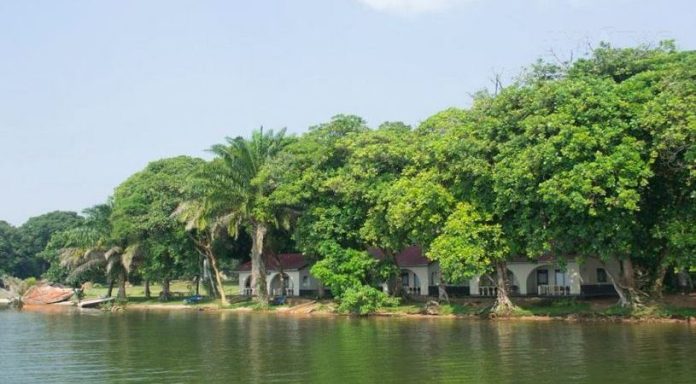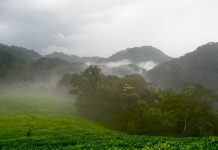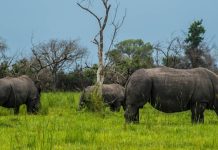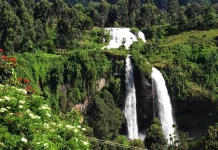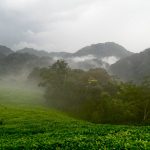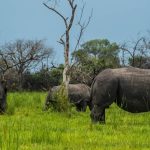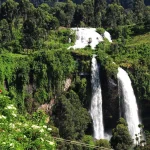Situated in the northwest of Lake Victoria, the Ssese Islands consist of 84 individual islands. Some of these islands are large and have a dense population, while others are small and uninhabited. These Ssese islands are lushly forested due to the annual rainfall exceeding 2000mm. The largest island in the Ssese group is Buggala, which accounts for more than half of the archipelago’s land area and lies 40 km southwest of Entebbe as the crow flies. Buggala’s principal settlement is Kalangala, which serves as the administrative center of the Kalangala district, encompassing a terrestrial component of 468 sq km and 8635 sq km of open water.
The Ssese Islands have a checkered history as a tourist destination. In the mid-1990s, when tourism to Uganda was still dominated by backpackers, Buggala emerged as the country’s most popular word-of-mouth chill-out destination. However, that changed later in the decade with the discontinuation of the Port Bell ferry, limiting safe access to Buggala to a more roundabout approach via Masaka and Bukakata. This shift opened the way for the more accessible Lake Bunyonyi to capture the hearts of independent travelers.
In recent years, the introduction of a daily passenger ferry from Entebbe has sparked a renaissance in tourism activity on Buggala, although facilities now cater more to Kampala weekenders than to backpackers. That said, Buggala, with its scenic lake vistas and practically limitless opportunities for casual rambling along lush, forest-fringed roads and footpaths, remains an utterly beguiling retreat. This is especially true on weekdays and for those seeking a more off-the-beaten-track and uncontrived alternative to the ever-busy Bunyonyi.
Wildlife in Ssese islands
This archipelago boasts a covering of mid-latitude rainforest, akin in composition to the forest that once covered the adjacent mainland. However, it is far less affected by agriculture and other forms of encroachment. The vervet monkey, a common large terrestrial mammal, is frequently spotted in the vicinity of Lutoboka and Kalangala. While bushbuck and black-and-white colobus are also present, they are seldom observed.
After Buggala became an island, unique animals developed there that can’t be found anywhere else. One special type of creek rat and three types of butterflies evolved just on Buggala. These creatures are exclusive to the island, making Buggala a special home for them.The diversity of water and forest birds is prolific. Expect to see a variety of hornbills, turacos, barbets, robin-chats, weavers, and flycatchers around Kalangala. Particularly common are the jewel-like pygmy kingfisher, intermediate to the orange and white phases. African fish eagles and palm nut vultures are often seen near the lake, while breeding colonies of little egret and great cormorant occur on Lutoboka and other bays.
History of Ssese islands
Little is known about the early inhabitants of Ssese, but some oral traditions linked to the creation of Buganda suggest that its founder, Kintu, hailed from the islands or at least arrived in Buganda via them. The Baganda traditionally hold Ssese in high regard as the islands of the gods. In pre-colonial times, it was customary for the kings of Buganda to visit the islands and pay tribute to several Balubaale, whose main shrines are located there. These included shrines to Musisi, the spirit of earthquakes, and Waneema, responsible for physical handicaps on Bukasa Islands, as well as the shrine to Mukasa, the spirit of the lake, on Bubembe.
Some Baganda historical sources romanticize this relationship, claiming that in pre-colonial times, Ssese, due to its exalted status, was never attacked by Buganda, nor was it formally incorporated into the mainland kingdom. In reality, while Ssese probably enjoyed a degree of autonomy, it was clearly a vassal of Buganda. Revering the island’s spirits, Stanley recorded that they looked down on their human inhabitants for their coal-black color, timidity, superstition, and generally unclean life.
One of the most popular legends associated with a deity from the Ssese Islands dates back to the mid-16th century war when Buganda, led by King Nakibinge, was being overwhelmed in a war against Bunyoro. Nakibinge visited the islands seeking support and was offered the assistance of the local king’s youngest son, Kibuuka, who leaped to the mainland in one mighty bind to join the war against Bunyoro. Despite his tall and powerful stature, Kibuuka, meaning “the flier,” possessed unique fighting skills.As a human-like deity, he could fly above clouds and surprise enemies by throwing spears from the sky. The enemies were confused as they couldn’t figure out where the deadly attacks were coming from. Led by Kibuuka’s aerial attacks, route followed route, and the tide of war swiftly reversed in Nakibinge’s favor as the Baganda army advanced deeper into Bunyoro territory.
Even though Buganda emerged victorious in the war, Kibuuka didn’t live long enough to enjoy the rewards of their triumph. After a victorious battle, Baganda soldiers captured Banyoro maidens, and one of them was given to Kibuuka as his companion. Kibuuka shared his secret with the Munyoro girl, only to discover the next morning that she had vanished overnight. The next day, Kibuuka ascended into the sky as he always did, but this time, he faced a storm of spears and arrows from the Banyoro below. He was wounded by the projectiles and fell into a tall tree. The following morning, an elder discovered Kibuuka in the tree and tried to rescue him. However, in the process, Kibuuka accidentally fell to the ground, where he succumbed to his injuries upon impact.
The scrotum, penis, testes, and other parts of the great Ssese warrior, now regarded as the greatest Lubale of war, were preserved in a shrine where his spirit could be called upon before important battles. The shrine, located near Mpanga Forest, can still be visited, as can a nearby shrine to Nakibinge, also revered as a deity for his successful campaign against Bunyoro. The shrine to Kibuuka was desecrated by the British during the colonial era, and its contents, including his jawbone, are on display in a museum in Cambridge.
How Ssese islands became to be in Buganda’s region
The Bassese people, residing on the islands and speaking a distinct Bantu language closely related to Luganda, were, as described by Stanley, the principal canoe builders and the majority of sailors for Buganda. They played a verifiable though less overtly aggressive role in Buganda’s expansionism during the second half of the 19th century. At this time, Kabaka Suuna and his successor Mutesa dispatched regular military fleets of 300 fighting canoes across Lake Victoria to present-day northwestern Tanzania. These fleets consisted almost entirely of canoes built on Ssese, which, in comparison with the simple dugouts used on the mainland, were highly sophisticated in design. They were constructed with several pieces of interlocking timber and boasted an extended prow that could be used to batter other boats.

Speke described a fleet of boats vividly: “Around fifty large boats, painted with red clay, each with ten to thirty paddles. They had long fronts resembling the neck of a swan or siphon, and at the head, there were horns of the nsuunu (kob) antelope with a tuft of feathers stuck upright, like a grenadier’s plume.” The islanders were better at rowing and navigating than their Baganda neighbors on land. Even though they didn’t directly fight, they usually powered and steered the war fleets.
In the late 19th century, the demands of the Buganda military imposed a heavy burden on the Ssese economy. So much so that in 1898, the islanders petitioned the British governor, complaining that they were regarded in Uganda as being inferior and subordinate to that country. They stated that the severe strain upon the island’s labor resources was so serious that it endangered the canoe services, now essential with the increasing demands on Victoria Nyanza Lake transport. In 1900, an agreement between Buganda and Britain placed Ssese and nine other formerly autonomous counties under the full jurisdiction of Buganda. In the next decade, Ssese faced a serious sleeping sickness outbreak, causing the government to move 25,000 islanders to the mainland due to the high number of yearly deaths.
The resettlement of Ssese happened slowly, mainly because of a sleeping sickness epidemic. By the mid-1990s, the total population of the island was believed to be fewer than 20,000. But since then, the number of people living there has grown quickly. It doubled from about 35,000 in 2002 to an estimated 70,000 in 2015.
Economic activity on Ssese islands
Although much of the land remains uncultivated and supports a cover of natural forest, Buggala also hosts a major palm oil industry. Until recently, it mainly consisted of local farmers who grew a few oil palm trees on their small holdings and sold the produce to the Jinja-based processor Bidco Uganda. This changed in 2011 when Oil Palm Uganda Limited (OPUL), a subsidiary of Bidco, controversially cleared 61 sq km of natural forest and small holdings west of Kalangala to make way for new oil palm plantations. Displaced local community members, some of whom were effectively squatters but nevertheless lost their homes or livelihoods in the land grab, have since taken OPUL to court demanding compensation.
Major Ssese islands
The Ssese Islands are divided into two main groups – the Koome Group and the BugalaGroup. The Bugala group is located in the southwest of Bugala Island, which is the largest in the group. It includes Bukasa, Serinya, Bubeke, Funve, Bufumira, Buyova, and Bugaba. The Koome Group islands are found after Koome Island, which is the largest in the group. They include Luwaji, Damba, and Koome.
While Buggala continues to be the primary tourist hub on the Ssese Archipelago, a noteworthy number of travelers also venture to the petite Banda Island. Additionally, other islands such as Bubeke, Bukasa, and Bufumbira can be visited with varying degrees of ease. Each island offers its unique charm, providing visitors with distinct experiences amidst the picturesque landscapes of Lake Victoria.
Ngamba island
Ngamba Island is mainly rainforest covering an area of about 100 acres that was transformed into a sanctuary for rescued and orphaned chimps in 1998. Ngamba Chimpanzee Sanctuary attracts a number of visitors each month who come to track chimps or volunteer as caretakers. Besides the chimps, Ngamba Island is home to over 119 species of birds and creatures like monitor lizards. Occasionally, hippos and crocodiles also visit the island.
The key attraction on Ngamba Island is the chimpanzees. These chimpanzees are brought here after being rescued from animal traffickers and some when their parents succumb to poaching. Upon arrival, the chimps are often traumatized from their harrowing experiences with poachers or animal traffickers. To prevent bullying by the adult chimps, the orphans are initially separated and gradually introduced to the rest of the community.
Visitors to Ngamba Island Chimpanzee Sanctuary have the opportunity to watch the chimps being fed before they return to the forest. Volunteers can actively participate in feeding the adults and assisting the orphans in adapting to life on the island.
Bugala islands

The island covers an area of over 205 square kilometers and stands as the largest among the Ssese Islands as it ranks as the 10th largest lake island globally. Bugala is the most popular and frequently visited island, being the most developed and suitable for tourists. It hosts Kalangala town, the administrative capital for most of the other islands. To reach the island, ferries dock at Luku.
Bugala Island boasts numerous hills, each offering splendid views of the lake, passing boats and ferries, as well as the bustling human activities taking place on the island.The island is a home to the largest palm oil plantation in Uganda that creates employment opportunities for island residents. Bugala Island offers birdwatching and primate viewing; most common primates on the island include Vervet Monkey, Colobus monkeys, bushbucks, and snakes can also be spotted. The southern end of the island is home to a small population of hippos. Bugala Island serves as a sanctuary for three endemic species: creek rats and three types of butterflies.
Due to significant human activity and revelers on Bugala Island, it tends to be noisy over the weekend. For those that need quieter and more remote visit islands like Bulago, Bukasa, and Banda are recommended.
Bulago island
Bulago Island is one of the largest of the Ssese Islands and covers an area of over 510 acres, approximately 2 miles in length. The island has sandy beaches and it is surrounded by numerous cliffs and protruding rocks. Bulago Island is an ideal destination for nature walks and a peaceful escape from the noisy city. From one of the hills on the island, visitors are rewarded with stunning views of the lake and distant islands.
Bulago Island is also a home to avian life, attracting both resident and migratory birds that gather to feed on the abundant fish and inland insects. One can get to Bulago Island by using a speedboat from Munyonyo which takes approximately 45 minutes.
Lutoboka island
There’s more to this beautiful bay than a ferry jet. Located 1 km downhill from Kalangala, the bay is sandy, forest-fringed, and offers a variety of beach activities, including swimming, although bilharzia is certainly a risk. Canoeing is also available at some resorts, along with the new nine-hole golf course at Ssese Islands. The forest encircling the bay hosts a wealth of birdlife, best seen from the dirt road running northwest of the jetty towards Victoria Forest Resort.
Other islands
The second-largest island in Ssese is Bukasa, situated on the eastern end of the archipelago and widely regarded as even more attractive than Buggala.The island is covered in dense forest, which is home to a wide variety of birds and monkeys. You can explore the island by walking along well-maintained roads, with the path to Rwanabatya being especially suggested as a great route to take. Individual points of interest on Bukasa include the beach at Misenyi Bay, a plunge pool ringed by the forest, and a waterfall. Several other small, mostly uninhabited islands can be reached by fishing boat as day trips from Buggala.
What to see and do on Ssese Islands
There are a variety of activities and excursions on Buggala Island. If you don’t fancy exploring on foot, you can also enjoy a cruise safari in Kalangala or rent bikes.
Sport Fishing
Sport fishing is one of the activities done in Uganda as it is always organized by various fishing villages as they aim at catching the largest fish. The most caught types of fish include Tilapia, but the ultimate prize is landing the Nile Perch, the largest fish in Lake Victoria. International visitors interested in sport fishing must obtain a fishing permit. One to do this activity should have a fishing gear which can be rented from the islands at a reasonable price
Although, it’s advisable to bring your own equipment for a better experience. If, for some reason, you prefer not to venture into the water yourself, you can simply observe the fishermen from a distance as they cast their nets. Incase one want to do this activity should organize with the tour operator for better experience
Village and Nature Walks
The Ssese Islands boast ample forest cover which provides opportunities for walks amidst lush greenery and vibrant flowers. Explore and visit one of the fishing villages to gain insight into the daily lives of the local people. It’s important to note that poverty and underdevelopment are still prevalent issues in the Ssese Islands. Many fishermen, despite their hard-earned income, often spend money on alcohol and other indulgences.
Visit the Nanziri Waterfalls
These waterfalls are located on Bukasa Island near Wanema’s shrine and the sacred Nanziri cave, these mysterious waterfalls are considered sacred by the locals. Visitors are required to remove their shoes and speak in very low tones as a sign of respect. The local guide will inform you of the rules to be followed while in this place.
While at the waterfalls, you will observe remnants of various sacrifices made to Nanziri, and considered to be the god of the waterfalls, and other spirits. These sacrifices made include coins, pieces of meat, and coffee beans. People from different walks of life visit this place to seek blessings, protection, wealth, and fertility. Fishermen, in particular, frequent the site to seek blessings before heading out to fish. The locals even believe that the water from the falls can cure various diseases.
Cultural Visit
The Ssese Islands stand as one of the last strongholds of Buganda’s ancient cultural practices. For those interested in learning more about Buganda’s traditional religions and culture, a visit to the Kihumuro Cave. The cave is about 40 meters long having a wide entrance with a small exit. In Baganda it is believed that the ancient gods and spirits rested in these caves. The custodian and his assistants of the caves are fond of smoking pipes as they pray to the gods like “Muwanga Jajja.” Those visiting the cave are supposed to remove shoes and follow specific rules.Inside the cave, you’ll find ancient artifacts like old spears, coffee seeds, bark clothes, and other sacred objects. This cave is often visited by important people in Uganda who seek blessings for their businesses and careers.
Another interesting place to explore is Wanema’s shrine in Bubeke. This shrine is well-organized and located in a large grass-thatched hut surrounded by a fence made of reeds. The shrine is attended by women and are always willing to share information about its origin. Those visiting this place pictures are not allowed, and there are other rules to follow to avoid offending the spirits. Sacrifices, such as chickens, goats, money, or even monkeys, are offered by those seeking answers to their worldly problems or claiming to have had their problems solved. However these ancient practices are gradually fading away. And many youth are leaving the islands for greener pastures, where they discover broader opportunities instead of remaining tied to these gods associated with smoke. Christianity and Islam are the two main religions in Uganda nowadays. Even though some people still visit the traditional shrines quietly, many are afraid to be linked with them. They worry about being judged as bad or old-fashioned.
Wildlife Viewing
The Ssese Islands are home to various primate species, including Vervet and Colobus Monkeys. Crocodiles occasionally visit some of the smaller islands, while hippos can be observed in the southwestern shores of Bugala. These large mammals, along with the elusive Sitatunga, favor the marshy shorelines due to lower human visitation. The Sitatunga in the Ssese Islands have evolved to have larger horns compared to those seen in wetlands elsewhere.
Quad Biking

Tourists can use quad bikes to explore the Ssese Islands, allowing them to visit the beaches, forests, and fishing villages while enjoying a great ride along the way. These quad bikes are primarily used on Bugala Island since they are all-terrain and do not require anyone’s prior experience with a motorbike. People of all ages can use these bikes, but the experience is even more enjoyable when done with friends or family. A training session is provided before heading out to the established circuits. Given the substantial size of Bugala Island, it’s advisable to bring a packed lunch. Quad biking for one hour costs approximately 70,000 Ugandan shillings.
Chimpanzee Tracking in Ngamba Island
Ngamba Island was established by the government and the Jane Goodall Foundation as a sanctuary for rescued chimpanzee orphans. Visitors are welcome to offer volunteer work on the island or simply visit to observe the chimpanzees in their natural habitat. Feeding the chimpanzees at the sanctuary is a popular activity among tourists, and the island also provides opportunities for birdwatching and boat cruises.
How to access Ssese Islands
There are two reliable options for reaching Buggala—either using a direct ferry from Entebbe or taking a more roundabout route via Masaka and Bukakata. When the Entebbe ferry is non-operational, you could also use a motorized lake taxi from nearby Kasenyi, which comprises the only public transport to the other smaller islands. However, it is possible to charter a lake taxi from Lutoboka to Banda Island.

By ferry from Entebbe
The MV Kalangala is a daily passenger and vehicle ferry service that connects Lutoboka Port on Buggala Island to Nakiwogo Port, which lies 3 km west of central Entebbe. The ferry departs from Nakiwogo at 14:00 daily and starts the return trip from Lutoboka at 8 am the next morning. It offers first and second-class seats, and vehicles are charged for a one-way crossing. Additionally, there is an option to park vehicles in a compound at Nakiwogo for a small fee. Onboard, passengers can purchase bottled drinks and snacks.
By ferry via Bukakata
A free vehicle ferry service connects the mainland port of Bukakata, which is 40 km east of Masaka city, to Luto, which is 30 km west of Kalangala, several times daily. Two different ferries cross back and forth regularly between 8:00 and 18:00, taking 30 minutes. However, the connection between their real-time movements and the complicated timetable posted at the port is tenuous at best. Therefore, it’s best to just show up when it suits you, as you may wait more than an hour for the next boat.
To reach Bukakata in a private vehicle, you can follow either of the routes to Lake Nabugabo. Using public transport, a reliable daily bus service to Kalangala via Bukakata leaves Kampala New Taxi Park at 8 am. Coming from Masaka, a few matatus run daily between Nyendo and Kalangala via Bukakata.
By lake taxi from Kasenyi
The main port for motorized lake taxis is Ssese Kasenyi, which lies 5 km east of Entebbe town as the crow flies but 11 km away by road. Lake taxis to Lutoboka tend to be overloaded and frequently capsize during stormy weather, causing up to 100 fatalities annually, so they cannot be recommended. Lake taxis from Kasenyi to Banda or Bukasa islands are no safer, but since they are the only direct option from the mainland, many travelers opt to use them.
